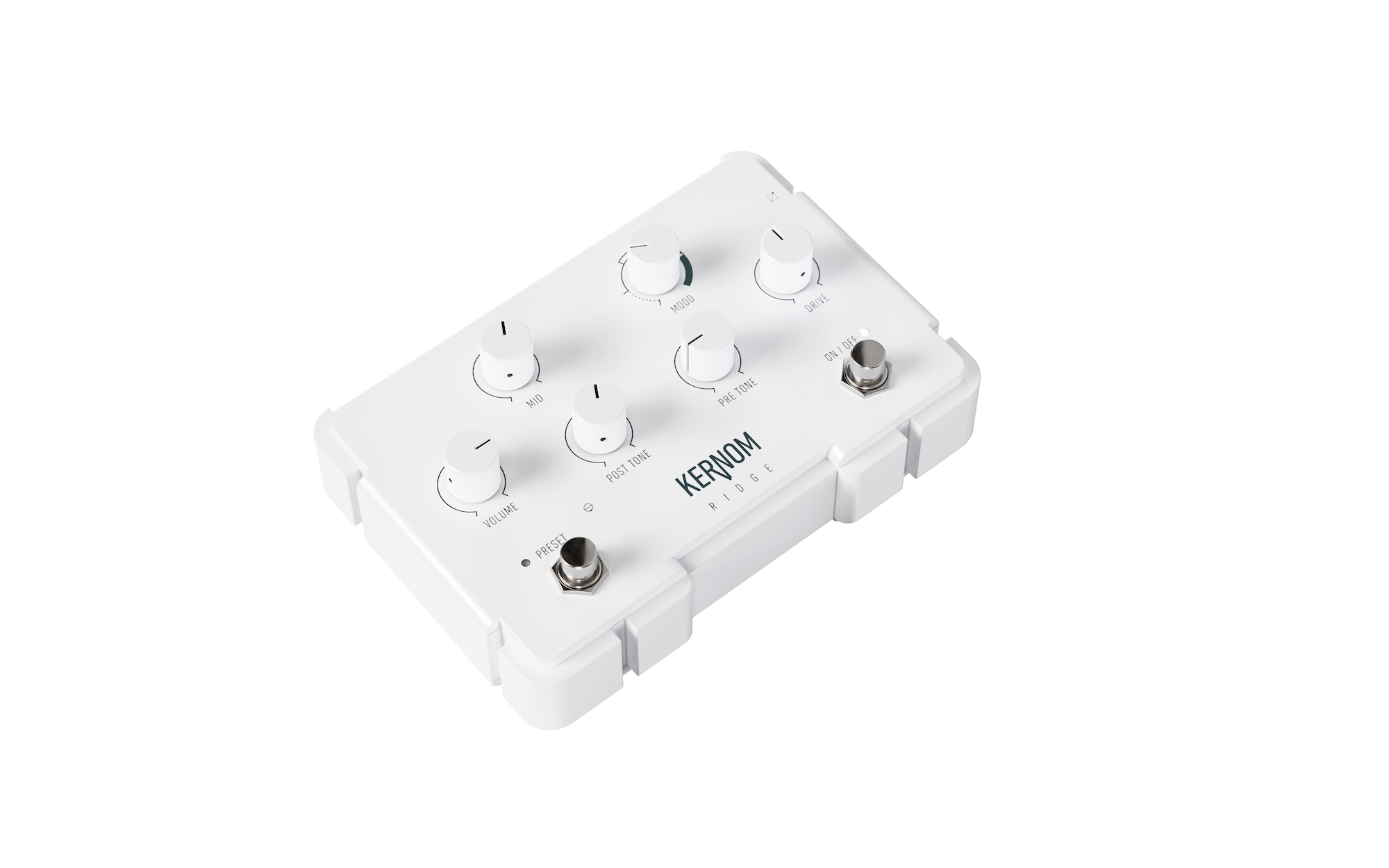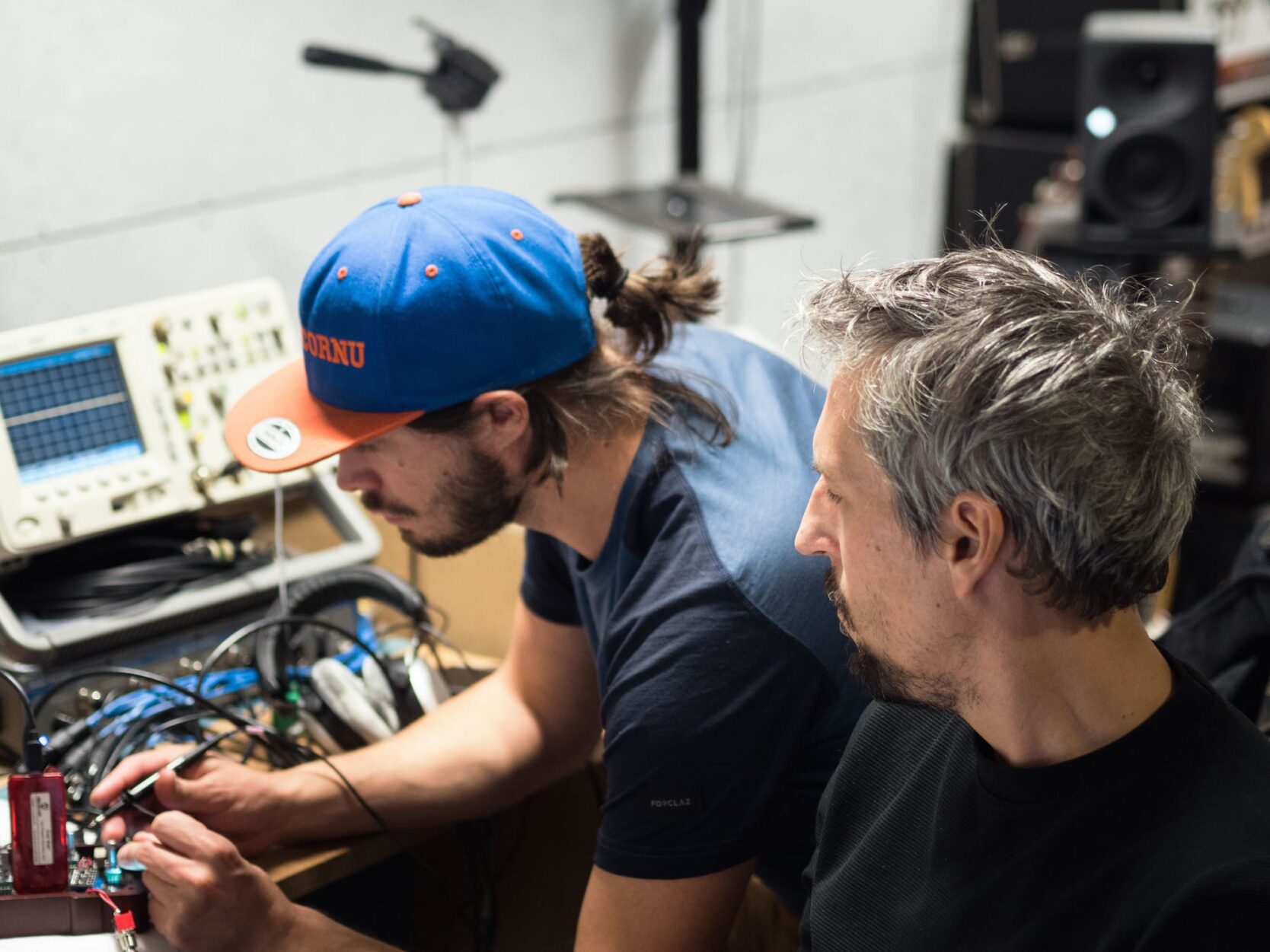Since the pandemic’s “hobby boom” grew the guitar effects pedal market exponentially, overdrive pedals are a dime a dozen. There are hundreds (if not thousands) of clones and variations on Tubescreamers, and nearly as many takes on the famous Klon circuit. Beyond the common ones, dozens (or possibly hundreds) of independent builders and small companies are constantly looking to make a name for themselves with unique overdrives that provide a different color to the tone or do something slightly outside of the norm — all while still delivering that light-to-mid crunch that people expect from a drive.
But while so many guitarists and companies alike are chasing the vintage tone of decades past, the French pathfinders at Kernom are exclusively looking toward the future. In an industry where the musical equivalent of classic cars reign, the Kernom RIDGE is equivalent to a Bugatti.
Without going too far into the technical side, the RIDGE doesn’t just deliver one overdrive sound, it delivers nearly all of the overdrive sounds. Between the six knobs and MIDI functionality (which provides access to a whopping 128 presets), the RIDGE can crank out anything from a clean boost to the filthiest distortion, each with a number of possible voicings/tones — and all without sacrificing the quality of any of them.
SPIN spoke with Charles Riche, the business quarter of the four-man operation, about the upstart pedal company and breaking the limitations of what people thought was possible for an overdrive.
SPIN: How did you and the other guys decide to start Kernom?
Charles Riche: So, Kernom was three people at first. It was myself and [the development team of] Antoine Petroff and Jeremy Savonet, and we all met a while ago while working for French audio company Devialet — which makes high-end speakers. Prior to that, Antoine had been a recording engineer for 20 years with his own studio, and we were all passionate about music. We started with the idea that we really liked analog gear for its ease of use, but at the same time, you had to have tons of pedals and switch between them to get different voices. You either had amazing pedals with one voice that sounded great, or you had multi-effects and digital units were very versatile, sacrificed a bit on both sound and ease of use. So we thought there must be a way to combine those two things to get a very cool-sounding product that’s easy to use and very, very versatile.
We didn’t all leave Devialet at once, but we all went our separate ways and then the pandemic happened. We got bored — like a lot of people — so we started talking about this idea again and decided to start the company.
What was it like to get your footing during the pandemic, when it seemed like everyone was launching a pedal company?
One of the most challenging things for us was that we couldn’t physically work together most of the time. We were working mostly out of Paris and we had very strict lockdowns at first, so it was really hard to test the prototypes and the tech since we couldn’t actually get together as often as we would’ve liked to. We obviously had quite a lot of experience working with factories, prototyping and developing complex products, but we didn’t know anything about the rest of the industry apart from being clients of it. That’s why we decided to do a Kickstarter in October 2021, because we wanted to see how a few people would react to the concept of our idea. We were still quite early in the development phase, but the first prototypes were already sounding pretty good. That Kickstarter allowed us to get a foot in the scene, and a few hundred people ordered the pedal, which allowed us to start working with the factory on manufacturing everything and make sure that everything would run smoothly.
How do you think that previous experience in high-end audio gear shaped the early days of Kernom?
There are a couple of things that really helped us. The first was really knowing how to design an efficient circuit that you can scale with contractors while having very low defect rates. I’m not an engineer, but the other two guys are really good engineers, and they built their first pedals when they were teenagers. So they were already fluent in the industry standard computer programs and things used to actually design [circuit boards] and everything. I think that really helped them to be quicker and more efficient in the prototyping and design phase.
The other thing is that we had contacts in electronics factories from our previous experiences, so we reached out to them when we were advancing on the project. We knew we wanted to work with mechanical engineers for the design of the casing, because even though it’s not a complex object, we needed it to be very sturdy, yet not that expensive. I think having those contacts really helped a lot.

The RIDGE is the most complex overdrive I’ve ever seen, yet still surprisingly easy to use without any menus or anything.
It is quite complex, and maybe it’s the most complex. I can’t say, because I don’t know every single pedal. But like I said, it all started with the idea of having one pedal that could do what all of the simple pedals that we all love would do. There’s all those iconic pedals that really made music what it is — they all sound amazing and they’re easy to use. So when we made our product, it had to be something that you could use daily and put on your pedalboard without extra steps getting in your way and preventing you from doing what you love. The last thing you want to do is get lost in programs and menus and submenus, and I think that’s one of the reasons why [analog pedals] are so popular. But if you want to play a Bon Jovi song and then a Beatles song and then an Iron Maiden song, those are all very different sounds that require different pedals or a multi-effects pedal where you have to dive into menus. We really wanted to help modern musicians to have access to gear that would perform, react and feel like the gear they love — the gear that contributed to writing the history of music — but would still meet their needs for versatility. We wanted no menus, so we added a few extra knobs — because knobs are cool and fun to turn. It’s all very simple to use, and if you’re the guy who freaks out whenever you hear “MIDI,” we still want you to feel like our pedal can bring something to the table for you.
Considering that the RIDGE was the first product from Kernom, what was it like to see the pretty huge fan reaction to it?
Well when we did the Kickstarter, we were really happy because we reached the funding goal that we’d set. We knew those early adopters would help us along the way. But then, we delivered the products to everyone, and we knew that we still needed just one big break that would make our voice heard. If no one knows you exist — even if you have a very cool idea of a product — nothing will happen. So we started reaching out to people like YouTubers and artists, and [YouTuber] Paul Davids did a video about it that really helped us start gathering attention. After that, people started calling us and it all snowballed. We received a lot of orders, but we didn’t really have any comparison points, so we never realized how popular it was getting. It just happened really quickly, and it’s been a wild ride. We have lots of ideas for the future, so we’re excited to start building this community around the brand, products and technology that we developed.
Is there anything you’d want to tell current or prospective RIDGE owners?
A lot of people — especially on YouTube — spend a lot of time figuring out how to replicate the tones of iconic music, and you can definitely do that with the RIDGE. You can clone a lot of existing and iconic gear, and we’ll never tell people “No, don’t do that,” because it’s obviously a very cool use case for us. But this is also why we haven’t released a list of different models within the RIDGE or said “OK, just put your nose in that position and you’ll get that pedal.” It’s all about the journey and finding your own voice. We wanted to allow musicians to really have access to every parameter of the overdrive sound and to explore. Maybe you start from somewhere familiar, but then you twist knobs at random and find something cool. Get yourself into accidents just and just have fun discovering cool stuff.





